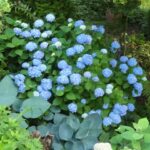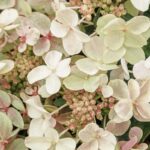If your hydrangeas live in the milder parts of the U.S. and Europe, and the spirit moves you, you can consider pruning only your new wood blooming hydrangeas now. It’s hard to conceive of that when you live where I do. Last March we had 3 Nor’easters. Not only did they bury everything, but the snow and ice made the footing much too dangerous to be using sharp tools. On the other hand, we have had an extremely mild February and early March looks to be the same. So maybe it’s safe to take the plunge.
Exactly which plants am I talking about? The ones that are foolproof and will produce flowers on the stems they will grow this year.
All of your woodland/smooth Hydrangea arborescens plants fall into this category. You may know them as ‘Annabelle’, Invincibelle Mini Mauvette™, Invincibelle® Spirit, and Incrediball®, along with others in their families. The same goes for your panicle hydrangeas like ‘Limelight’.
Get your tools in order
Before you start, however, get your tools in order. A good cleaning, oiling, and sharpening now will pay dividends and make your job much easier. Make sure you have a good pair of gloves, a tarp, a bypass pruner as shown in the photo, a lopper, disinfectant spray, and/or anti-bacterial wipes at the ready.
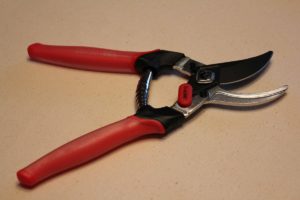
Cleaned/Disinfected Bypass Pruner
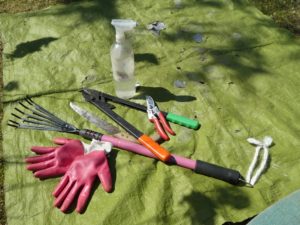
Assorted Pruning Tools
Fine Gardening ran an excellent article about Sharpening pruners which I recommend. It has a 10 minute video embedded in it with Lee Reich which you might find helpful.
Fit your pruner to your hands
The best advice about pruning tools I can give you comes from Corona Tools, a U.S. manufacturer of garden tools and so much more (www.coronatoolsusa.com/). Corona has been around for over 90 years and not only do they know tools, but they know how to FIT a tool to you.
Look at these very helpful graphics from Corona of how to make sure your pruner is the right fit for your hands.
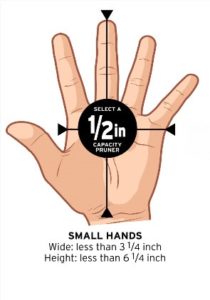
A small hand needs a pruner no higher than 6 inches.
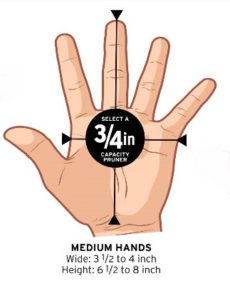
A medium hand can take a 7 inch pruner.
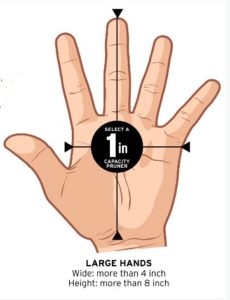
A large hand needs an 8 inch pruner or more.
There’s nothing worse than working with a pruner that doesn’t fit your hand. And only you are the judge of that.
If you have some time to cruise the internet, you can find lots of videos on caring for your cutting tools. The key is to DO IT! Not just this once but throughout the season as sap, dirt, and debris will always clog your pruners and dull the cutting surface. That translates into jagged cuts, a potentially less healthy plant, and more work for you. You might need to invest in some diamond hones and other small items, but that investment will pay you great dividends.
How much to cut
Back to your pruning job. How much do you cut back on new wood flowering plants? Good question! I wouldn’t go further down than about 2 feet tall. You want to give the plant the ability to have strong stems to hold the deliciously large flowers, especially after rainfall. If you cut it to the ground or to its crown, as I have seen on various websites, you will wind up with weak stems. Those magnificent flowers hold water, which will weigh them down unless they have strong “old” stems to keep them erect.
A before and after shot of your plant might look like this:
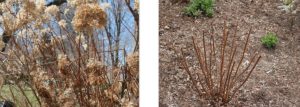
Woodland/smooth hydrangea before and after pruning.
All Hydrangea paniculatas like ‘Fire and Ice’, Fire Light®, ‘Limelight’, Pinky Winky®, and Little Quick Fire® are new wood bloomers. They too can be cut back now. There is some research that shows cutting by about a third is the right amount for these plants. Before and after shots of ‘Limelight’ from my garden looked like this one spring.
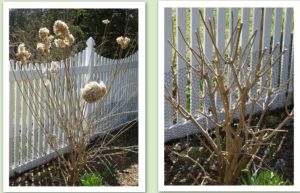
‘Limelight’ hydrangea before and after pruning.
Make sure as you move from plant to plant that you disinfect your cutting tools. You don’t want to unintentionally move pathogens around your garden. Disinfecting is easy. You can use Lysol® spray on your tools to get into the crevices which can harbor the invisible germs. Studies prove it kills most germs in an average home garden. Your other choice is to make a spray of a 10% solution of rubbing/isopropyl alcohol from your home medicine cabinet using a spray bottle from the dollar store. Don’t forget to wipe down your gloves/hands.
For cold weather gardens, I would hold off a little while more. We still have to deal with March, which can be harsh on your plants. You want to let Mother Nature take her best shot and allow for winter kill before you take the pruners to your plants. Plus, your footing needs to be safe and with sharp cutting tools, you want to be super careful. If your fingers are itchy to be out in the garden, take the time to get those cutting tools in shape. Clean, sharpen and oil them so they’re ready for the hard work ahead.
What about pruning other hydrangeas
Don’t even think about cutting any of your other hydrangeas, no matter how ratty they may appear. Oak leaf hydrangeas, big leaf hydrangeas, climbing hydrangeas and mountain hydrangeas all bloom on old wood even if they are rebloomers. You must leave all of them alone. For them, you are in the HYDRANGEA DANGER ZONE™ (HDZ™), that time between August 1 and when you see buds. The HDZ™ is when those buds are most susceptible to all kinds of mayhem, but that shouldn’t include your pruning cuts. Their time will come soon enough, and you will be glad you let your plants get the last of their beauty sleep.
Pruning new wood hydrangeas is something you can master with a little time and attention. You’ll find them forgiving even if you make a mistake or two. Just be sure you prune them before they are too far along for this season or you’ll miss your window.
I cover pruning in detail with loads of photos in my book Success With Hydrangeas, A Gardener’s Guide.
Upcoming talks
Why not plan to attend one of my upcoming talks? My March public speaking schedule might be of interest to you as I delve into a variety of topics. Maybe there’s a location convenient for you to come and hear me cover a subject of interest to you. There are several hydrangea talks, including pruning. Stop by and say hello.
- Mar 7, Cornell Cooperative Extension of Rensselaer County Spring Garden Day, 2 p.m.; “Smarter Gardening”, https://tinyurl.com/va43up7;
- March 14: I will be talking hydrangeas on Ron Wilson’s radio show from Ohio twice on Saturday, March 14. Ron is a highly regarded plantsman and manages one of Ohio’s premiere nursery/landscape companies. He’s also the past president of the Ohio Nursery & Landscape Association. The first discussion will be at about 7.30 a.m. and again at about 11 a.m. To listen live or later, go to https://www.ronwilsononline.com. If you are in the Ohio listening area and want to listen the old-fashioned radio way, here’s what you need to know:
- First show from 6 to 9 a.m. is based out of Cincinnati: 55KRC, WKRC 550AM;
- Second show from 10 to 12 noon is based out of Columbus at 610 WTVN, which serves most of Ohio;
- You can also download the free iHeart app to listen to any of Ron’s shows anytime from anywhere;
- Don’t forget to check out Ron’s latest blog posts at https://ronwilson.iheart.com/
- Mar 18, Wellfleet Gardeners, Cape Cod , MA, 10 a.m. “Shrubs, The New Perennial”;
- Mar 21, CT Master Gardeners’ Symposium, New London, CT; 11 a.m. & 1.30 p.m., “Hydrangeas for Cold Climate Gardens”, https://ctmga.org/2020-symposium-information.
Here’s to happy hydrangeas, not just a myth but a reality!
6 Secrets for Stunning Hydrangea Flowers
Get my FREE mini-guide with 6 fool-proof tips showing how to grow hydrangeas that produce the most amazing flowers.
No spam - I promise!


